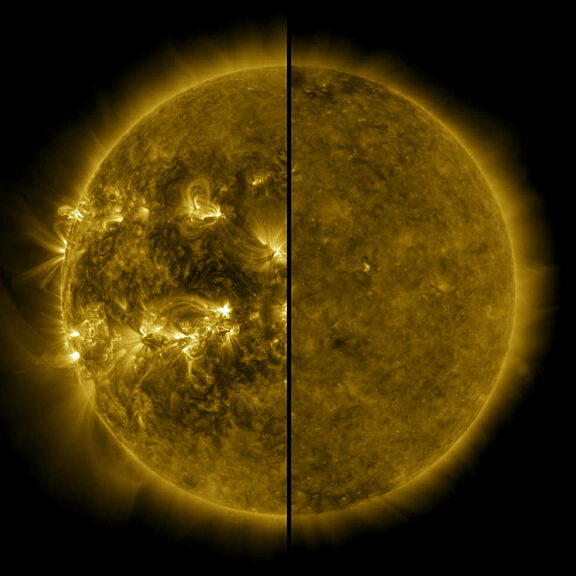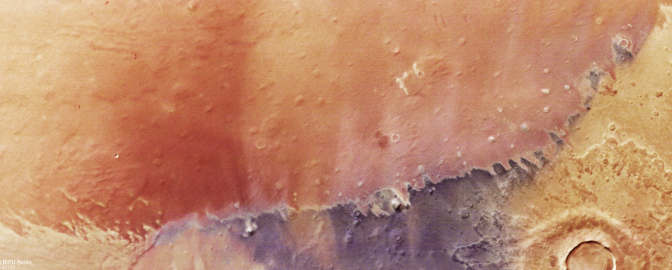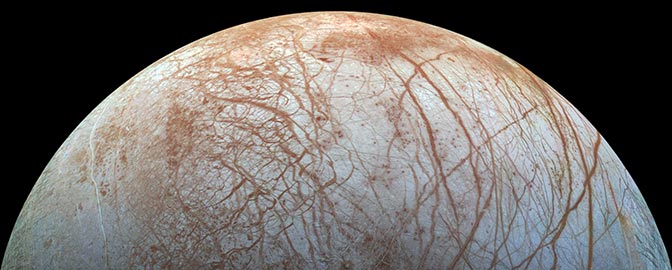The Sun, our Solar System’s star
How the Sun drives space weather, affects life on Earth, and why we study it
Highlights
The Sun is a gigantic, roiling ball of plasma. Nuclear fusion in its core produces heat and light, ultimately powering life as we know it on Earth.
Solar storms frequently launch plasma and radiation into the Solar System. If an intense storm hit Earth, it could damage satellites, power grids, and communication networks.
We study the Sun to learn about how stars work, and to help protect our civilization from solar storms.
Where did the Sun come from?
The Sun formed 4.6 billion years ago from a gigantic collapsing cloud of gas and dust called the solar nebula. The leftover material from the Sun’s formation — a mere 0.14% — evolved into the rest of the Solar System we know today: planets, moons, asteroids, comets, and all.
How does the Sun work?
The Sun exists in a delicate balance. Its gigantic mass — over 300,000 times that of Earth — experiences a huge gravitational pull toward collapse. But another force at work in the Sun pushes back. Down in the Sun’s core, the weight of the rest of the star above makes for enormous pressures as well as temperatures upward of 15 million degrees Celsius (about 27 million degrees Fahrenheit). These conditions are intense enough to fuse hydrogen atoms into helium, releasing staggering amounts of energy in the form of light and heat. That energy acts against the Sun’s own gravity, and its outwards push keeps our star stable.
What's it like inside the Sun?
The Sun is made up of plasma, a gas-like state of matter that conducts electricity. This plasma behaves differently in different layers of the star. There’s the core, where fusion takes place. Above that is the radiative zone, where energy is mostly carried outward in the form of light, and then the convective zone, where moving plasma carries more energy instead. Then you finally reach what is usually considered the surface of the Sun, where most light can stream freely out into space. This region is called the photosphere, and it's the part of the Sun you typically see with your naked eye.
The Sun also has two outer layers beyond the photosphere: the chromosphere and the corona. Both the chromosphere and the corona are usually invisible to the naked eye, except for during a total solar eclipse. Then, with the brighter parts of the Sun blocked out, the chromosphere can be seen as a reddish ring while the corona looks like gossamer streams of white.

Why research the Sun?
Without the Sun, life as we know it would not be possible on our planet. The Sun is the engine behind much of Earth’s environment, providing energy for everything from ocean currents and weather patterns to the plants and algae that form the base of many food chains.
The Sun is the easiest star for us to study, making it very useful to the field of astrophysics. It's the closest star and the only one we can visit to explore. Proxima Centauri, the next-nearest star, is light-years away.
What we learn from the Sun can teach us about other stars in the Milky Way galaxy and beyond. It can reveal aspects of some of the Universe's most exotic phenomena, like supernovae and black holes. Learning how the Sun’s energy affects the hundreds of billions of kilometers of space surrounding it also gives us a sense of how space weather affects Earth, and even how stars influence the prospects of life on other planets.
What will happen when the Sun runs out of fuel?
Because the Sun is steadily undergoing hydrogen fusion, it’s called a main sequence star. But it won’t always be at this stage of its life. In about five billion years, the Sun’s core will run out of hydrogen and transition toward the red giant stage. Nuclear reactions will transition to mostly taking place in a thin shell around the core, and the solar atmosphere will eventually cool. The Sun will expand to engulf Mercury, Venus, and maybe even Earth’s orbit.
Meanwhile, other worlds farther from the center of the Solar System may thrive. Instead of their current frigid selves, places like the moons of Jupiter and Saturn could become warm enough to sustain liquid water on their surface and, potentially, life. Even worlds as far out as Uranus and Neptune, or Pluto and the other dwarf planets, could become temperate, though it’s unclear for how long.
Finally, about eight billion years from now, the Sun will completely run out of material for fusion and collapse into a white dwarf. The outer Solar System — from the gas giants Jupiter and Saturn outward — will survive, moving the planets’ orbits farther from the Sun. At that point, our star will be dim, and the remaining planets cold and dark.

What are sunspots?
We know from hundreds of years of observations that the Sun’s level of activity is linked to sunspots: dark blotches on its surface that appear, grow in number and size, diminish, and go away as the Sun’s magnetic field cycles roughly every 11 years. Sunspots appear dark because they are somewhat cooler and less luminous than their surroundings, though they are still very hot. When the Sun has the most sunspots — which we still track by hand — scientists call it a solar maximum. That is when solar storms are most frequent. During a solar minimum, which last occurred in December 2019, the Sun is quietest.
What is solar wind?
Earth and the other planets in the Solar System actually lie in the extended atmosphere of the Sun. This ongoing stream of charged, energetic particles is called the solar wind. It carries the Sun’s magnetic field far away from the center of our Solar System, beyond the orbits of Neptune and Pluto. As it races through the Solar System at hundreds of kilometers per second, the solar wind erodes the atmospheres of planets like Venus and Mars. It also causes comets to develop ion tails.
When the solar wind reaches Earth, our magnetic field largely deflects it and protects us from its harmful radiation. A slightly more intense solar wind often interacts with Earth’s atmosphere and magnetic field in ways that create beautiful glowing auroras. But when particularly strong solar activity hits Earth, it can do a lot more than put on a light show.
What are coronal mass ejections?
The Sun’s most powerful eruptions, called coronal mass ejections, release billions of tons of material into space. When these storms hit Earth, they can cause fluctuations in our planet’s magnetic field that damage infrastructure, especially things that depend on electricity. During the strongest such event in recorded history — back in 1859 — telegraph lines caught fire and shocked operators.
If the Sun were to emit a coronal mass ejection of such intensity at Earth today, its impact on society would be much more harmful. A huge storm could damage satellites, take down power grids, disrupt communications, and endanger astronauts.

Exploring the Sun
We can learn a lot about the Sun by observing it through telescopes from Earth. But if we want to really understand our star, we have to send probes.
In 1974, the HELIOS 1 spacecraft made history when it became the first probe dedicated to orbiting and studying the Sun (technically Luna 1 was the first probe to orbit the Sun, but that was by accident after it missed the Moon). A joint venture between NASA and the German Aerospace Center (DLR), HELIOS 1 made a variety of foundational measurements of the solar wind and the environment near the Sun.
Almost two decades later, a joint European Space Agency (ESA) and NASA mission called Ulysses took a more unusual path to study the Sun. Using Jupiter’s own gravity as a slingshot, Ulysses was able to travel around the Sun at a steeper angle compared to how the planets orbit. It became the first spacecraft to survey the space around the Sun’s poles. Ulysses’ instruments showed that the Sun’s magnetic field is carried out into the Solar System in more complex ways than expected and that its poles emit weaker magnetic fields than previously thought.
Breaking away from the solar wind
In 2012 and 2018, respectively, NASA’s two Voyager probes became the only human-made objects to enter interstellar space. That boundary is defined by where space stops being dominated by the solar wind and instead begins to feature particles and radiation that mostly come from the galaxy at large. As each probe made the journey, it transmitted valuable data back to the Jet Propulsion Laboratory (JPL), which built and operates both spacecraft.

Monitoring solar activity
Space agencies have launched a number of missions to track the Sun’s weather. In 2006, NASA launched the twin Solar TErrestrial RElations Observatory (STEREO) spacecraft in orbits that lead and trail Earth in its journey around the Sun. The two probes’ combined perspectives, coupled with Earth-based observatories and other space telescopes, allowed scientists to track solar eruptions in 3D. NASA could detect sunspots and eruptive features even as they were developing on the Sun’s far side. Though astronomers permanently lost contact with STEREO-B in 2016, STEREO-A is still operational.
Launched in 2010, NASA’s Solar Dynamics Observatory (SDO) monitors the Sun at a variety of wavelengths that are each sensitive to different aspects of our star’s structure. Combined with the spacecraft’s observations of the Sun’s magnetic field, SDO gives scientists a more complete picture of the Sun’s active regions and helps them understand exactly how solar flares develop and erupt. Using this knowledge, scientists predicted seven out of the nine biggest solar flares in the last solar cycle.
The ESA-NASA Solar and Heliospheric Observatory (SOHO) has been observing the Sun uninterrupted for over 25 years from Lagrange point 1, a region of space between Earth and the Sun where the two bodies’ gravities balance in a way that make orbits more stable. SOHO’s coronagraph blocks sunlight to effectively create solar eclipses on-demand, providing conditions where it can better see the corona and track solar eruptions. Other state-of-the-art missions carrying coronagraphs include India’s Aditya-L1 solar observatory — which joined SOHO at L1 in 2024 — and ESA’s Proba-3 mission, which launched that same year to study the Sun's corona.
Current missions to the Sun
In 2018, NASA launched the Parker Solar Probe toward some of the most extreme conditions a space mission has ever faced: the spacecraft is studying the Sun from within the corona itself.
The Parker Solar Probe uses Venus’ gravity to slow down and get closer to the Sun. With every Venus flyby, the spacecraft swings deeper into the Sun’s corona and observes the solar wind closer to its origin, where it is turbulent and twisted, unlike the smoother flow it develops near Earth. In 2025, the Parker probe will be just 6 million kilometers (almost 4 million miles) above the Sun’s surface — nine times closer than scorching Mercury.
In its passes through the Sun’s outer corona so far, the Parker Solar Probe has revealed intriguing features that the solar wind near Earth, or even Mercury, lacks. These include zigzag spikes along which the magnetic field rapidly flips, like a wave traveling through a rope. Scientists think these “switchbacks” are fundamental to understanding how the solar wind originates and accelerates.

The Parker Solar Probe can’t point any imaging instruments directly at the Sun because the heat would quickly destroy them. This is where the ESA-led Solar Orbiter mission, launched in 2020, comes in. Solar Orbiter will take the closest pictures of the Sun ever, along with the first-ever close images of our star’s polar regions. The probe will also measure the properties of solar wind particles. While its closest point to the Sun lies just within Mercury’s orbit — not as close as the Parker Solar Probe — Solar Orbiter will still allow scientists to trace solar wind particles down to where they originate on the Sun’s surface.
One of the biggest mysteries both missions intend to solve is why the Sun’s corona is so much hotter than its surface. Scientists have been debating since the 1940s how the Sun’s outer atmosphere is heated to more than 1 million degrees Celsius (2 million degrees Fahrenheit) while the surface temperature remains a comparatively cool 5,800 degrees Celsius (about 10,000 degrees Fahrenheit). This is part of why the Parker probe is studying the corona from within.
Scientists suspect the heating of the corona is tied to the Sun’s complex, intertwined magnetic field. To investigate this, Solar Orbiter will make detailed maps of the Sun’s magnetic field on and below its surface.
Solar Orbiter’s initial close-up images of the Sun have already turned up promising clues. It has seen numerous tiny solar eruptions across the Sun’s surface, each with temperatures similar to the corona. Some scientists think these "nanoflares" play a major role in heating the corona. Future images may tell us more. In the coming years, Solar Orbiter will incline its orbit to image the Sun’s poles up close and measure the drastically different magnetic field and solar wind there.
Current missions are providing profound insights into the Sun and its activity. From space weather monitoring missions to probes that visit the Sun up close, we are gaining a more complete understanding of how stars work and what it means to live with one. In the future, these efforts may help us minimize the danger posed by solar storms.
Acknowledgments: this page was initially written by Jatan Mehta in 2021. It was revised by Asa Stahl in 2025.


 Explore Worlds
Explore Worlds Find Life
Find Life Defend Earth
Defend Earth

